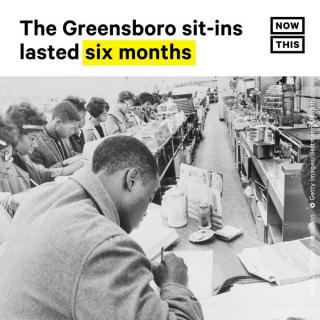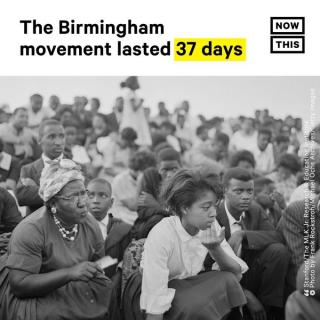Don’t Let the Movement Die Down
By Kyra Bellamy
The Black Lives Matter Movement began in 2013 after the murder of Trayvon Martin. Trayvon, a teenage African American boy was followed by a suspicious neighborhood watchman. The two ended up getting in a scuffle, and Trayvon was fatally shot. After the shooting, many Americans, especially Black Americans, were outraged when they found out that Trayvon’s killer, George Zimmerman, would not receive any jail time for his crime. Since then, an enormous number of similar cases have surfaced involving Black people both young and old. Well-known cases over the past several years include the murders of Sandra Bland, Eric Garner, Philando Castile, Tamir Rice, Breonna Taylor, Sean Reed, George Floyd, and so many more.
The current uprising has mainly been in response to the murder of George Floyd. Floyd was accused of using a counterfeit $20 bill to pay for items at a store. After the police were called, a white officer, Derek Chauvin, pressed his knee on Floyd’s neck for almost nine minutes, ultimately killing him. This famous case that happened about a month ago has sparked a movement demanding a complete reform of policing in this country, and it doesn’t seem like it’s stopping anytime soon. This is now the fourth week of protests. But why does the news show that the movement is dying down? This new movement has now seen protests in all 50 states, as well as dozens of countries. The American people are fed up with the overuse of force and murders committed by police departments across the United States.
News outlets all over the country are making it look like the protests are fading, when in fact they are still going strong. Police officers, including the killers of Breonna Taylor, have still not been arrested or convicted for their wrongdoings, so the protests continue. But why isn’t the mainstream media showing this? One theory is that since the police have stopped showing up to protests, looting and chaos have also died down, which is a good thing. Protestors, for the most part, have been able to protest and go home. In the first week or two of protesting, when peaceful protests turned to riots, this was because of the excessive presence of police and other militia. The riots were heavily filmed and reported on by the media, causing the protests and Black Lives Matter to be shown in a negative light. Since there is little to no police action at current protests and no juicy story to film, these peaceful protests haven’t been getting much coverage.
About a month ago, some American citizens were protesting their right to go back to work, get haircuts, and enjoy the many amenities their cities have to offer. A video of these (white) protestors from one state went viral, showing them getting violent with police officers, screaming in their faces, and nothing happening to them. The contrast is striking compared to police reactions to the Black Lives Matter protests incited after the murder of George Floyd. In these clips, peaceful protestors are mistreated by police officers, some for simply just standing, walking away, or even obeying the orders of law enforcement.
Although some people are keeping up the fight to end racial inequalities, it seems like a difficult task for others. Many people may not feel directly affected by Black Americans being murdered by the police or by systemic racism. This may be because of their race or their economic status, which gives them privilege to overcome or ignore these issues. We need these people, those with more power and privilege, to keep up the fight. One suggested task has been refusing to purchase goods from companies that have favored and donated to openly bigoted institutions and campaigns. However, especially for those products that are popular, that tactic is difficult to enforce widely. This should not be the case. Refusing to purchase from these companies is just one small fraction of what can be done during this fight, and some cannot even do that. We cannot let the movement die down.
Although many brands and companies have celebrated diversity in the past, it seems as though some are only using this moment as a publicity stunt to make themselves look good in order to maintain their Black audience and consumers.
Black Out Tuesday was a social media strike on June 2, 2020. This social media strike urged people to refrain from posting on social media about their own personal lives or brands, and instead post about our current racial climate and educate others. Those that were uninformed on the issues of today were encouraged to educate themselves by watching documentaries, reading books, or engaging with any other forms of media. I personally saw many brands posting for Black Out Tuesday, but nothing else. Beforehand, they did not acknowledge this country’s many racial inequalities and afterward they made no effort to educate their consumers. It was if they just wanted everyone to know their brand wasn’t racist or problematic. This is not okay. Several “Instafamous” creators were seen showing up to protests, taking a picture to prove they were there, and then leaving. All of this was done to look good for their audience. But the thing is, activism is not a trend to follow. People’s lives are in grave danger, the systems in place are unjust and are disproportionately hurting communities of color – and have been for generations. For the sake of all those lives at risk, we cannot let the movement die down.
The Civil Rights Movement of the mid-20th century lasted over a decade. Even though the movement did resolve some race-related issues for Black and Brown people in the United States, not everything was rectified. Mass incarceration, redlining, and other forms of systemic racism then became the next plague; this is what we’re faced with today. But protesting for three weeks will not change the whole system around. It requires a lot of work. The Montgomery Bus Boycott, which happened because of racial segregation of buses, lasted 382 days: a little over a year. The Greensboro Sit-ins, which allowed Black and White people to be served in the same fashion at restaurants, lasted six months. These are just a few examples of what our revolutionary ancestors did. I emphasize again: Do not let the movement die down.
In the past couple of weeks since the protests began, many things have been accomplished. The use of a chokehold was banned by many cities in the United States including Minneapolis, Washington D.C., Chicago, and Denver. The charges of one of the police officers that killed George Floyd, Derek Chauvin, were upgraded to second degree murder while the other two officers were also charged. Racist statues are being removed from cities, oftentimes by its citizens. Some police departments are even being defunded. Although this is great news, it is not enough; it’s just scratching the surface. Racism and systemic oppression are deeply rooted in the United States. The country was founded on a system of harm towards people of color, and in today’s world, small changes are not going to cut it. So, do not let the movement die down.
As someone who is not a Unitarian Universalist but working for a UU organization, I am learning about the UU liberal religion, among this learning being the seven Unitarian Universalist Principles. Although all of the Principles show the importance of everyone being accepted, no matter who they are, where they come from, or how they identify, a few stand out to me in importance to this issue: the issue of racial injustice and the militarization of the police in the United States.
The First Principle is “the inherent worth and dignity of every person,” the Second Principle stating, “justice, equity and compassion in human relations,” and finally the Sixth Principle, “the goal of world community with peace, liberty, and justice for all.” Remember each and every one of those key words in the Principles. Right now, and for the past 400 years or so, Black people in the United States have not been granted this privilege. People of color in the United States have not been granted this privilege. Although it is definitely the goal, there is still work to do. Don’t let the movement die down.
The Unitarian Universalist Principles state that every person should be treated fairly and that is not happening in the United States with the criminal justice system we currently have in place. In order for this to happen the Unitarian Universalist Association says that it’s time to defund the police. Your friendly neighborhood cop has been replaced by a militarized police force; this needs to come to an end.




